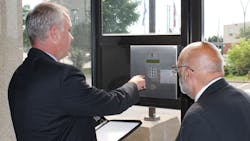Violence in academic institutions is a sad reality faced by those responsible for the safety of students. When such events occur, the shock, grief and anger that ripple through communities heighten awareness of the need for steps that prevent or lessen those losses.
A reactive response can result in greater atrocities, which is a tragedy of its own kind. Although catastrophic events aren’t a certainty on every campus, the lack of a site-specific plan to deal with the possibility of one puts the lives of students and staff at risk.
The reactive cycle
Without adequate planning, preparation and training to anticipate and respond to a security crisis, teachers and administrative staff are left with merely one posture of response: a reactive one. This increases the risks—when threats aren’t detected in advance, they cannot be prevented or deterred.
At the onset of a crisis, a reactive cycle occurs when teachers and administrators default to what is known as the Boyd Cycle to formulate a response. The Boyd Cycle has four steps:
1. Observation of the events.
2. Determining what resources can be brought to bear in response.
3. Deciding on a plan of action.
4. Initiating that action.
Without a plan, responders are forced to operate from a hasty, sometimes knee-jerk posture. That may lead to more damage or loss because of the influence of shock on decision making. Before leadership can even begin to observe and devise a plan, shock has to be overcome. Even then, shock may continue to impair decision making or delay the associated actions.
Failure to plan
Why, then, do so many organizations leave themselves vulnerable to crises by operating reactively? Financial constraints and other restrictions frequently limit how much of an investment is made into developing a site-specific plan.
Yet, developing a plan does not need to be costly. Some interventions are virtually free to put into place: optimizing the location of the school’s security officer’s office, changing lockdown procedures or requiring school staff to carry keys at all times. Innovative technologies such as enhanced CCTV cameras and intrusion-detection systems are being developed, but changing behaviors and procedures may be some of the best defenses against attacks.
Legal considerations involving student privacy and confidentiality are common and legitimate constraints as well, as in the case of closed-circuit television. Plans need to honor the rights of the people they are meant to protect. Concerns over a building’s image and aesthetic learning environment are another common objection. No parent wishes to send a child to a school that resembles a bunker. Furthermore, even in the wake of shooting attacks such as Sandy Hook and Virginia Tech, many academic institutions fear that more stringent security will alarm students.
Without a proactive plan, an institution’s response to a security crisis follows a similar pattern. Administrators and teachers are forced to respond from a reactive posture. Their most immediate goal is to mitigate the extent of damage incurred, lives lost or injuries sustained. Once the situation is resolved and the crisis dissipates, the process of recovery begins by enlisting support from various professionals. Then, the institution strives to resume instruction and return to normalcy as soon as possible.
Yet, an unproductive undertone of worry over the possibility of similar events occurring in the future carries forward. Without a plan, a school is no better equipped to handle the next crisis than it was the last and, consequently, fear or worry persists.
A better approach
Having a plan to deal with security threats bolsters the confidence of instructors and administrators when they are confronted with a crisis, just as emergency response plans for fires, earthquakes or tornados help prepare education institutions for those calamities. However, security planning has an additional, and perhaps more important, benefit: It may reduce the likelihood of such threats occurring. The cycle no longer is exclusively one of response. It includes phases of assessment to identify site-specific risks and vulnerabilities. Customized plans, based on the unique aspects of a campus such as the location of windows and building construction materials, are devised to deter would-be assailants. The plans include methods of detecting threats early. Training the staff to meet crises with new protocols reduces the impairing effect of shock if a security breach arises.
Emergency response protocol dictates that medical professional personnel cannot enter a school building until law-enforcement authorities, who deem the area safe and the threat contained. As a result, the need for classroom teachers and professors to be trained as the first responders to an emergency is all the more imperative. If teachers are better equipped to tend to medical needs during the critical time between injury and the arrival of medical respondents, more students may survive an attack.
Many security firms recommend installation of closed-circuit television and electronically controlled magnetic locks in schools to aid in isolating an attacker within a building. With the ability to unlock individual doors selectively, law enforcement officers can better maintain the safety of students in classrooms while pursuing the aggressor. Perpetrators of school shootings in Connecticut, Virginia, Colorado and even Beslan, Russia, plotted their attacks by using the Internet to garner information and emulate the tactics of terrorist operations. A carefully planned and executed attack demands a carefully planned response.
Having a plan will not guarantee that no students will become casualties in an attack, but preventing the death of even one student is well worth the cost and effort of proactively developing a plan to deter, detect and mitigate security threats to the school. Not devising a site-specific, comprehensive plan because of fear that students might be unduly alarmed or an institution’s image might be tarnished is an untenable position.
Waiting until a catastrophe occurs is too late. Planning and preparation in advance of a crisis removes much of the shock and enables a more expedient and level-headed response, which may save lives.
Ericksen is vice president of ITG Consultants, Inc., Rockton, Pa., which provides training, consulting and security management services.

